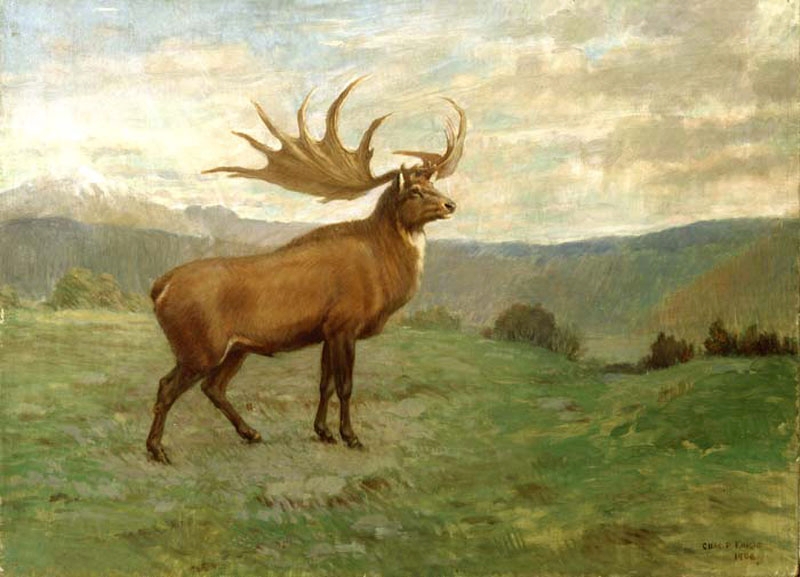The Irish Elk

The Irish Elk, Megaloceros, is misnamed, for it is neither exclusively
Irish nor is it an elk. It is a giant extinct deer, the largest deer species
ever, that stood up to seven feet at the shoulder (2.1 meters), with antlers
spanning up to 12 feet (3.65 meters). The Irish elk evolved during the glacial
periods of the last million years, during the
Pleistocene
Epoch. It ranged throughout Europe, northern Asia and northern Africa, and a
related form is known from China. The name "Irish" has stuck because
excellent, well-preserved fossils of the giant deer
are especially common in lake sediments and peat bogs in Ireland. The
skull on display at the old UC Museum of Paleontology
came from such a locality, 18 miles north of Dublin. Such skulls, with
their enormous racks of antlers, adorn the walls of castles and hunting
lodges throughout Ireland. On the other hand, the complete skeleton pictured
at the top of the page, on display at the Paleontological
Institute in Moscow, was found at the other end of Europe, near the
Russian town of Sapozhka.
Unable to adapt to the subartic conditions
of the last glaciation or the marked transition that occured after the
final retreat of the ice sheet, the largest deer that ever lived became
extinct, the last one in Ireland dying around 11,000 years ago.
Megaloceros may have possibly survived in continental Europe into
historic times.
Beyond its arresting size and singular appearance, the giant deer
is of great significance to paleontologists because of the way in which the
animal has become involved in evolutionary debates down through
the years.
Can Extinction Happen?
In the seventeenth and eighteenth centuries, it was becoming increasingly
apparent that many fossils represented organisms that were not known to
survive anywhere on Earth. But to scientists who believed in the Divine
creation of the Earth and its life, this posed a jarring philosophical
problem: why would a good, perfect God allow any of the animals in His
perfect creation to die out completely? Many scientists denied the reality
of extinction, and instead suggested that animals known only as fossils
would one day be found alive in some unexplored part of the globe. In the
words of Dr. Thomas Molyneux, the first scientist to describe the Irish
elk:
That no real species of living creatures is so utterly extinct, as to be lost
entirely out of the World, since it was first created, is the opinion of
many naturalists; and 'tis grounded on so good a principle of Providence
taking care in general of all its animal productions, that it deserves our
assent.
Molyneux erroneously identified the Irish elk with the American moose, while
others thought the Irish elk was identical with the European reindeer.
Not until 1812 did the great French scientist
Georges Cuvier document that
the Irish elk, along with other fossil vertebrates such as the mammoth,
did not belong to any living species of mammal. Cuvier's study of the Irish
elk was a key part of the documentation that extinction had happened in the
past.
Orthogenesis: Evolution in Straight Lines
A once-popular hypothesized evolutionary mechanism was
orthogenesis, in which change in organisms was due not to natural
selection, but to internal directional trends within a lineage. The
Irish elk was once considered a prime example of orthogenesis: it was thought
that its lineage had started evolving on an irreversible
trajectory towards larger
and larger antlers. The Irish elk finally went extinct when the
antlers became so large that the animals could no longer hold up their heads,
or got entangled in the trees.
Although orthogenesis was a common evolutionary theory in the 19th and early
20th centuries, it has since been abandoned for lack of a plausible mechanism.
It is perfectly possible, however, to reconcile the huge antlers of
Megaloceros with evolution by selection. Some paleontologists suggested
that the enormous weaponry of the Irish elk served a defensive purpose,
to kill predators and fight off rivals for mates.
A more modern interpretation of the function of the antlers in the
giant deer suggest that they were used for sexual displays, as they are in
living deer. Some living deer use their antlers in ritualized combats at
mating time, in which few individuals actually get hurt. It is possible that
the Irish elk used its antlers in this way, but there is another
possibility: The antlers of the Irish elk face forward, to show maximum
area when the animal looks straight ahead. They may not have been used in
combat at all, but simply served as visual signals during courtship. Whichever
is the case, sexual selection is the most likely explanation for why the
antlers of Megaloceros were so huge. The larger and stronger
the antlers, the more successful in mating the male deer would be, and the
more offspring he would have — offspring which could inherit parental genes
for large antlers.

No comments:
Post a Comment